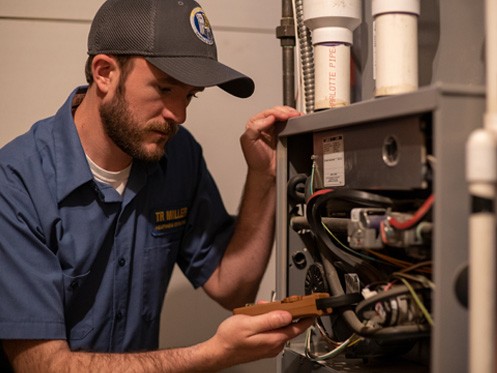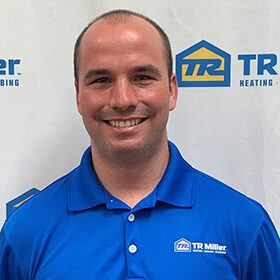The importance of good air quality in our homes cannot be overstated. Since we spend a significant amount of time indoors, the air quality we breathe greatly impacts our health and well-being. However, indoor air quality can negatively be impacted due to outdoor pollution, insufficient ventilation, or a malfunctioning HVAC. Poor air quality can affect your concentration, mood, and even sleep. In addition, it can impact your comfort and aggravate your allergy or asthma symptoms.
Understanding signs of can help you prioritize good air quality to create a healthier and more comfortable indoor environment. Here are seven signs to keep an eye on that may indicate your indoor quality may be suffering.
1. Dust Buildup and Inconsistent Air Distribution
If you notice dust particles built up in the corners of your house, walls, or ceilings, you likely have an air quality issue that you need to address. Dust can accumulate on surfaces such as the tops of home appliances, tables, shelving, and carpeting. You stir particles into the indoor air whenever you move around your house. At the very least, dust buildup can trigger or aggravate asthma or allergy symptoms. You can easily address this problem with a HEPA filtration add-on or air filter upgrade.
Dust and other air pollutants can also accumulate within your ductwork and vent covers, leading to an inconsistent distribution of conditioned and heated air in your home. If some parts of your house are too hot in the summer or too cold during winter, then you may have an air quality problem.
Uneven temperatures in your house may also mean you have filtration problems. Have a skilled technician inspect your HVAC unit to determine the cause of your inconsistent air distribution and help you develop solutions for proper filtration and even temperatures.
2. Too Moist or Too Dry Air
Another sign of low air quality in your house is indoor humidity problems. If your home’s humidity regularly exceeds 50%, this could result in mold growth. Dust mites and pests also thrive in moist environments. On the other hand, low humidity is a serious problem too. If your indoor humidity goes below 30%, which is common in some areas during the winter, your skin could get itchy, dry, and flaky.
Your mucous membrane might also dry out, leading to irritation, swelling, painful cracks, and a high risk of infection. Extremely low humidity can also cause your wood furniture, trim, or boards to split.
Running a dehumidifier with your air conditioning unit in the summertime can help maintain the appropriate indoor humidity levels. You can also benefit from a whole-house humidifier to keep your house comfortable during the cold winter.
3. Cold Symptoms and Sleeping Difficulties
Low indoor air quality can cause you to experience cold symptoms occasionally such as sinus pain or pressure and/or a runny or congested sinus. These symptoms may also persist beyond the usual period of a normal cold, which is the point where you may want to consider if your air quality could be the cause of said symptoms.
Indoor air contaminants can make it difficult to fall or stay asleep. Your indoor humidity level and temperature can also affect your sleep quality. If you are not getting quality sleep at night, addressing problems with your home’s HVAC equipment can help you achieve that.
4. Unpleasant Smells
If you start noticing prominent, unpleasant smells, they may be due to due to pet dander, pollen, and dust buildup, especially in spaces not getting enough air filtration and cleaning.
Unpleasant smells may also indicate biological growth due to high humidity. Smells from cleaning and cooking may linger in your indoor environment if you have poor air circulation or inadequate ventilation. If you have lingering odors in your indoor environment, chances are air contaminants are hanging around as well.
Using exhaust fans can help ventilate the vapors and odors out of your living space. Investing in an air purification system can also eliminate these indoor air contaminants.
5. Nausea or Headaches
Exposure to strong odors or chemicals like household cleaners and pesticides can result in lingering headaches. Leaving the garbage too long can also contribute to air quality issues and subsequent headaches.
Carbon monoxide and fumes can pose problems to your family’s health. You may experience nausea and dizziness. If not addressed in time, carbon monoxide can compromise your health.
If your symptoms disappear after leaving your residential property, it’s important to call an expert to check your gas mains for possible leaks. Poorly maintained appliances such as cookers, gas fires, clay ovens, and gas boilers can cause carbon monoxide leaks, leading to low air quality.
Installing carbon monoxide detectors and scheduling regular inspections for your fuel-burning appliances can help prevent air quality issues.
6. Biological Growth
Biological growth is another common symptom of low indoor air quality. If you notice mildew or mold growing on your walls, cabinets, cardboard, wallpaper, or other surfaces, your house certainly has an air quality issue.
When mold develops, it releases spores that float through the indoor air till they get an ideal surface to begin a mold colony. Breathing these spores can worsen allergies or asthma and even trigger respiratory ailments.
Mold growth indicates poor air circulation and excessive humidity in your home. A whole-house fan and dehumidifier are good solutions for these problems.
7. Irritated or Dry Skin
Irritated or dry skin is associated with indoor pollutants and poor air quality. If your home has air quality issues, you might notice flaking, peeling, redness, or dryness on any part of your skin.
Poor air quality can also cause you to develop unexplained rashes on the skin. If you notice new rashes, it might be due to prolonged exposure to spores, dust, and other contaminants in your indoor air.
If you have ruled out fiber allergy, or a change in body soap or detergent, the air pollutants in your indoor environment might be to blame. Poor air quality can also exacerbate your symptoms, especially if you suffer from acne, eczema, or other skin conditions.
Frequent vacuuming using a unit with HEPA filters can improve air quality. Upgrading your HVAC unit’s filtration and professional duct cleaning can also eliminate the contaminants irritating your skin.
Contact the Air Quality Experts
Poor air quality is an invisible hazard that can impact your comfort and health. Watch out for the above warning signs of low air quality in your Plainfield, IL, residence so you can act if your living space is affected. If you are experiencing air quality problems, our trained and experienced experts at TR Miller Heating, Cooling & Plumbing can help. Our team of professionals will conduct a thorough inspection of your residential property, identify sources of pollution, and recommend effective ways to clean and enhance your home’s indoor air quality.
We also specialize in mini-splits, boilers, air handlers, heat pumps, sump pumps, filters, air conditioning, plumbing, heating, and gas leak detection services. Call our customer representatives today to schedule your air quality service appointment.


